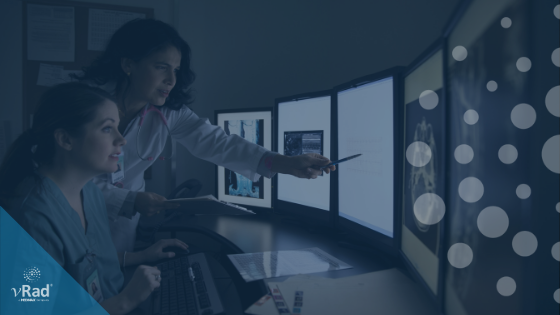How We Successfully Put AI Models to Work for Our Radiologists
For the latest information on vRad’s Artificial Intelligence program please visit vrad.com/radiology-services/radiology-ai/ Two components are...

Remote radiologist jobs with flexible schedules, equitable pay, and the most advanced reading platform. Discover teleradiology at vRad.

Radiologist well-being matters. Explore how vRad takes action to prevent burnout with expert-led, confidential support through our partnership with VITAL WorkLife. Helping radiologists thrive.

Visit the vRad Blog for radiologist experiences at vRad, career resources, and more.

vRad provides radiology residents and fellows free radiology education resources for ABR boards, noon lectures, and CME.

Teleradiology services leader since 2001. See how vRad AI is helping deliver faster, higher-quality care for 50,000+ critical patients each year.

Subspecialist care for the women in your community. 48-hour screenings. 1-hour diagnostics. Comprehensive compliance and inspection support.

vRad’s stroke protocol auto-assigns stroke cases to the top of all available radiologists’ worklists, with requirements to be read next.

vRad’s unique teleradiology workflow for trauma studies delivers consistently fast turnaround times—even during periods of high volume.

vRad’s Operations Center is the central hub that ensures imaging studies and communications are handled efficiently and swiftly.

vRad is delivering faster radiology turnaround times for 40,000+ critical patients annually, using four unique strategies, including AI.
.jpg?width=1024&height=576&name=vRad-High-Quality-Patient-Care-1024x576%20(1).jpg)
vRad is developing and using AI to improve radiology quality assurance and reduce medical malpractice risk.

Now you can power your practice with the same fully integrated technology and support ecosystem we use. The vRad Platform.

Since developing and launching our first model in 2015, vRad has been at the forefront of AI in radiology.

Since 2010, vRad Radiology Education has provided high-quality radiology CME. Open to all radiologists, these 15-minute online modules are a convenient way to stay up to date on practical radiology topics.

Join vRad’s annual spring CME conference featuring top speakers and practical radiology topics.

vRad provides radiology residents and fellows free radiology education resources for ABR boards, noon lectures, and CME.

Academically oriented radiologists love practicing at vRad too. Check out the research published by vRad radiologists and team members.

Learn how vRad revolutionized radiology and has been at the forefront of innovation since 2001.

%20(2).jpg?width=1008&height=755&name=Copy%20of%20Mega%20Nav%20Images%202025%20(1008%20x%20755%20px)%20(2).jpg)

Visit the vRad blog for radiologist experiences at vRad, career resources, and more.


Explore our practice’s reading platform, breast imaging program, AI, and more. Plus, hear from vRad radiologists about what it’s like to practice at vRad.

Ready to be part of something meaningful? Explore team member careers at vRad.
2 min read
 Brian (Bobby) Baker
:
August 12, 2019
Brian (Bobby) Baker
:
August 12, 2019

For the latest information on vRad’s Artificial Intelligence program please visit vrad.com/radiology-services/radiology-ai/
Early hype implied that artificial intelligence would replace radiologists. Turns out the opposite is closer to the truth. Without radiologists there is zero potential for the future of AI in diagnostic imaging. Radiologists are integral to model development, testing and validation.
We are beyond theory and academic papers and are implementing substantial, results-driven AI solutions in real time to improve patient care, as Imad Nijim reported in his recent post.
For example, vRad AI models score studies for the probability of various pathologies. Results can be used to adjust worklist prioritization, ensuring that patients with a high probability of critical conditions are getting treated as quickly as possible.
In addition, we use AI to monitor for non-emergent cases that have critical pathologies and prioritize them as well. There are many processes in place both at vRad and the facilities we serve to avoid these situations, but if a study were to slip through the cracks of existing processes, AI would be in the background as another layer of assurance that patients get the care they need.
The true potential of AI will only be achieved by engaging both radiologists and technologists every step of the way.
Well-annotated data is the single most important factor in AI success. Before my tech team members can develop and refine algorithms and processes, they seek input from our radiologists. Radiologists pair with our data scientists to define use-cases, annotate images, explain diseases and conditions, and provide guidance. Together we ascertain how software might assist diagnoses, and prioritize where AI assistance might promise the greatest potential to improve patient outcomes.
Clinical expertise is crucial. Radiologist involvement throughout the development and validation processes helps ensure our solutions have high clinical value.
One of our core tenants is to ensure that AI models work with our extremely heterogeneous data set. We call this “validation in the wild.” With more than 2,000 facilities across the United States, our set of DICOM images, tags and reports comprises an extremely diverse group of patients presenting an enormous variety of factor combinations.
Of course, this is the data that our 500 radiologists work with every day. So first, we have to understand how they process this mountain of information into diagnostic insights, providing clinicians with what they need to create the right care plan for each patient. Then we work with the radiologists to develop AI models designed to help improve process efficiency or accuracy.
Finally, validation requires that each AI model is put through “the funnel” – a series of increasingly rigorous testing stages. This includes using natural language processing (NLP) to “measure” the model for specificity and sensitivity. We do measurements in the lab on large data sets, and can also test how a model performs operationally in real time with hundreds of thousands of studies, employing NLP to “read” the reports for comparison against the model.
Radiological expertise is essential in every stage of design, development and validation. Radiologists provide the vision to carefully measure each model against the intended use case, while taking into consideration potential clinical variations.
I recently shared some additional thoughts on imaging AI in a Radiology Business article: “The new era of AI in medical imaging, and what it means for patients.”
For more on our program, visit our website.
Back to Blog
For the latest information on vRad’s Artificial Intelligence program please visit vrad.com/radiology-services/radiology-ai/ Two components are...
-3.png)
How well does your workstation and platform meet your needs to work efficiently, effectively, and without frustration? In my five years working...
.png)
For the latest information on vRad’s Artificial Intelligence program please visit vrad.com/radiology-services/radiology-ai/ ...
vRad (Virtual Radiologic) is a national radiology practice combining clinical excellence with cutting-edge technology development. Each year, we bring exceptional radiology care to millions of patients and empower healthcare providers with technology-driven solutions.
Non-Clinical Inquiries (Total Free):
800.737.0610
Outside U.S.:
011.1.952.595.1111
3600 Minnesota Drive, Suite 800
Edina, MN 55435